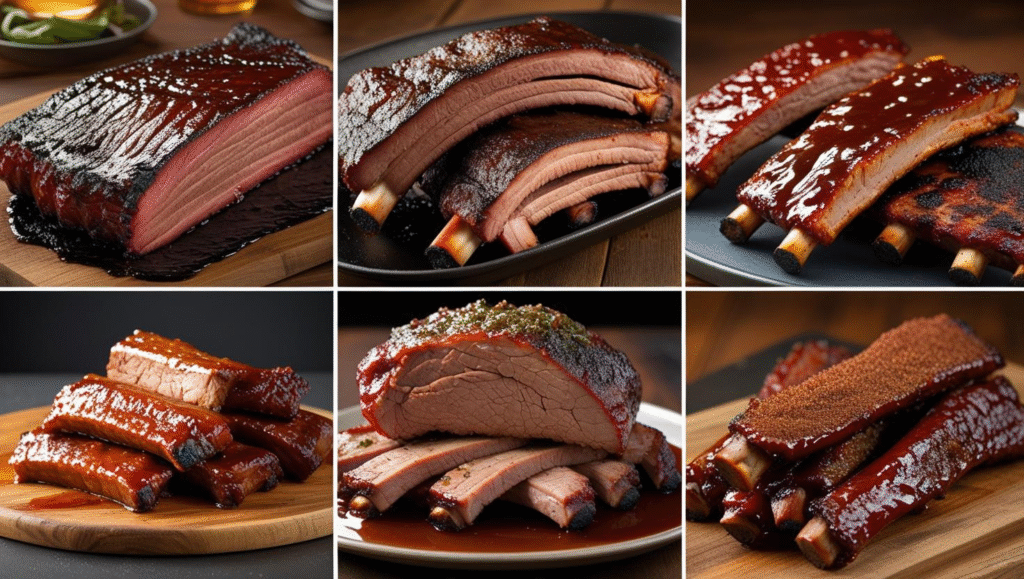Brining Times for Different Meats: The Ultimate Guide
Brining is a magical process that can transform a dry, bland piece of meat into a tender, juicy, and flavorful masterpiece. But while the concept is simple, the execution requires a crucial element: time. Brining for too short a period will yield no results, while brining for too long can result in a mushy, overly salty disaster. So, what’s the secret? The answer lies in understanding the brining times for different meats.
This guide will demystify the science of brining and provide you with a comprehensive chart and all the knowledge you need to master your next cook.
The Science of Brining Time: What’s Happening?
At its core, brining is about osmosis and protein denaturation.
- Osmosis: The salt in the brine solution moves into the meat, carrying moisture and flavor with it. This process is driven by the difference in salt concentration. The duration of this process is what dictates the required meat brining times.
- Protein Denaturation: The salt also works to break down the muscle fibers, causing them to unravel. This allows the meat to absorb and hold onto more moisture, preventing it from drying out during cooking. The longer the brine, the more the proteins will be affected. This is why getting the brining times for different meats right is so important—it’s a delicate balance.
The Golden Rule: The size and density of the meat are the most significant factors that influence how long to brine meat. A small, lean piece like a chicken breast will brine much faster than a large, dense pork shoulder.
Essential Brining Times for Poultry
Poultry, especially the lean breast meat, is particularly susceptible to drying out during cooking, making it an ideal candidate for brining.
Chicken
- Whole Chicken (4-6 lbs): For a whole chicken, a wet brine of 4-6 hours is sufficient. For a dry brine, allow 12-24 hours. The goal is to get the brining solution deep into the meat without over-salting the thinner parts.
- Chicken Breast (boneless, skinless): This is one of the fastest-brining cuts. A wet brine of just 30 minutes to 1 hour is often enough. Any longer and you risk a spongy texture. For a dry brine, 1-2 hours is all you need.
- Chicken Thighs/Legs: These are fattier and more forgiving than breasts. A wet brine of 2-4 hours works well. A dry brine of 8-12 hours will also give you great results.
Turkey
The holiday bird is a classic candidate for brining.
- Whole Turkey (10-20 lbs): This is where brining turkey times become crucial. For a whole turkey, a wet brine should be 12-24 hours. A dry brine requires 24-48 hours.
- Turkey Breast: A turkey breast, similar to a large chicken, needs a wet brine of 4-6 hours or a dry brine of 12-24 hours.
- Suggested Image Alt Text: A whole chicken submerged in a large container of wet brine, ready for a standard brining recipe times cook.
Essential Brining Times for Pork
Pork responds incredibly well to brining, with the process ensuring a juicy pork result, especially during long cooks like smoking.
Pork Chops
Pork chops can be very lean and benefit from a quick brine.
- Pork Chops (1-inch thick): A wet brine of 1-2 hours is perfect. For a dry brine, 2-4 hours is a great starting point.
- Thick-Cut Pork Chops (1.5-2 inches): These will require a longer brine to penetrate the center. A wet brine of 4-6 hours or a dry brine of 8-12 hours is recommended.
Pork Roasts
This is where brining can save you from a tough, dry mess.
- Pork Tenderloin: This very lean cut is prone to drying out. A wet brine of 2-4 hours will ensure a juicy result. A dry brine is not recommended for this cut.
- Pork Butt/Shoulder: The sheer size of this cut requires a long brining time. For a large pork butt, a wet brine should be 12-24 hours. A dry brine works exceptionally well here and requires 24-48 hours. This is one of the most important pork brining times to get right for pulled pork.
Essential Brining Times for Beef & Other Meats
While less common, some beef cuts also benefit from brining, particularly for corned beef or pastrami.
- Corned Beef/Brisket: A brisket for corned beef is typically brined for a much longer period to achieve a specific flavor and texture. This process is less about tenderizing and more about curing. It can take 5-7 days.
- Thick-Cut Steak: For a thick-cut steak, a simple dry brine of at least 1-2 hours, or up to 24 hours, will enhance flavor and moisture retention without making it too salty. You can learn more about this process in our guide on Wet Brining vs Dry Brining.
Comprehensive Brining Times Chart
This chart provides a quick reference for the optimal brining times for different meats.
Pro Tips and Common Brining Mistakes
Even with the right brining times chart, small mistakes can make a big difference.
- Don’t Over-Brine: This is the most common mistake. Leaving meat in a brine for too long will make it overly salty and give it a mushy, ham-like texture. If you’re using a strong brine, the brining times for different meats will be shorter.
- Adjust for Brine Strength: The times listed are for a standard brine (1/4 cup salt per quart of water). If you use a stronger brine, you must shorten the time.
- Rinse After Brining: Always rinse your meat thoroughly after a wet brine to remove excess surface salt. This will prevent a salty crust. This is also important if you are trying to get a crispy bark, so you don’t end up with a soggy bark.
- Consider a Dual-Purpose Method: If you’re starting with a frozen piece of meat, you can actually thaw and brine it at the same time. We cover this technique in our guide on Can You Brine Pork While It’s Frozen?.
FAQ
Q: Can I use table salt for brining? A: It is recommended to use kosher salt. Table salt contains additives and is denser than kosher salt, so the measurements will be off, leading to a much saltier brine.
Q: Do I need to pat meat dry after brining? A: Yes, this is a crucial step. Patting the meat dry after a wet brine removes surface moisture, which helps you achieve a proper sear or crispy skin. This is a fundamental part of getting the brining for doneness right.
Q: Is it okay to over-brine meat? A: No. Over-brining will make your meat unpleasantly salty and can change the texture, making it firm and dense. Always stick to the recommended brining times for different meats.
Q: Does brining work for all types of meat? A: Brining works best for lean proteins like chicken, pork, and turkey. While it can be used on beef, it’s not as common, as beef is fattier and more flavorful on its own. It is not recommended for fatty fish like salmon.
Conclusion: Trust Your Guide, Not Your Gut
Brining can elevate your cooking to a professional level, but the key to success lies in respecting the process and the timings. Now that you have a comprehensive guide to brining times for different meats, you can confidently approach any cookout, knowing you have the knowledge to deliver a juicy, flavorful result every time. Remember to factor in the size and type of meat, and don’t be tempted to rush the process. After all, a little patience is the secret ingredient to a truly perfect meal.






